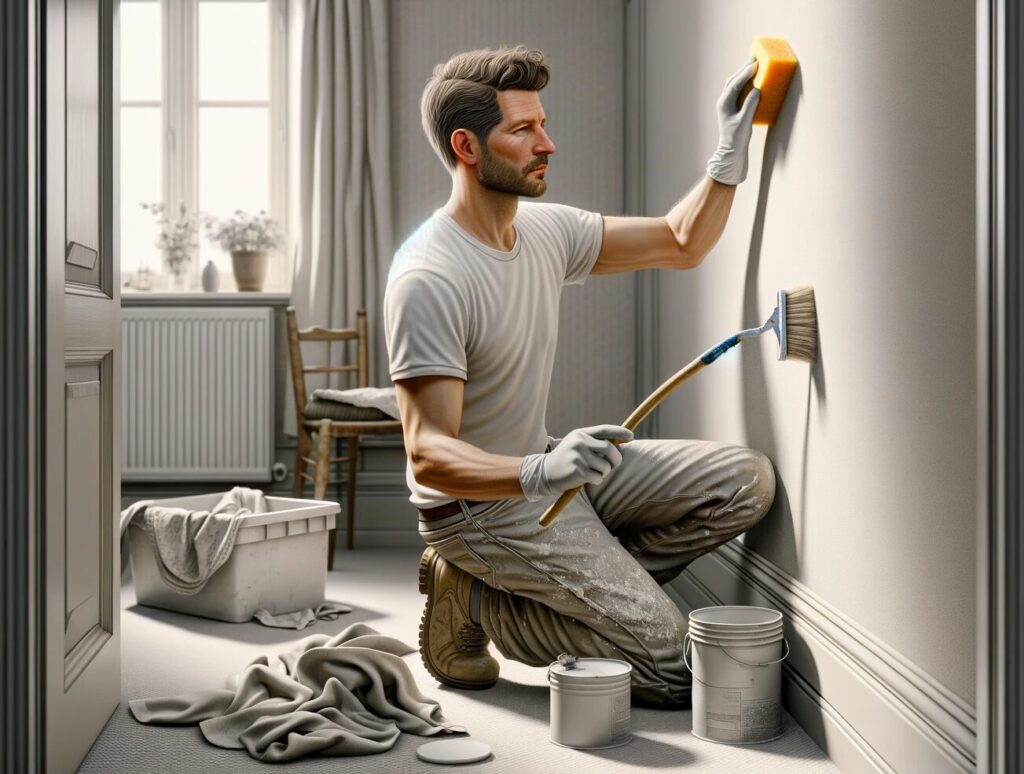Welcome to the world where a bit of elbow grease and the right know-how can transform any space. Cleaning walls before painting is more than just a preparatory step, it’s the foundation for a paint job that not only looks fantastic but also lasts. Whether you’re a DIY enthusiast tackling your home improvement project or a seasoned pro refurbishing apartments, this guide is tailored for you.

Understanding the Basics
Paint and unclean surfaces are like oil and water – they don’t mix well. The presence of dirt, grease, or even the faintest smudge can hinder your paint’s ability to adhere properly. It’s like laying a carpet on an uneven floor, no matter how beautiful the carpet, the flaws underneath will show through. Similarly, a well-cleaned wall ensures your paint goes on smoothly and stays there. Plus, have you ever seen how blemishes can bleed through paint over time? We’re here to prevent that.
Materials and Tools Required
Let’s roll up our sleeves and gather our tools. It’s not just about having the right equipment, it’s about how you use them:
- Sponges: Versatile and essential. Use them to gently wash surfaces without leaving marks.
- Mild Detergent: Think of it as the gentle persuader for most of your wall cleaning needs.
- Trisodium Phosphate (TSP): When you encounter those stubborn stains, TSP is your go-to. But remember, it’s potent, so handle it with the care it deserves.
- Gloves: An absolute must when working with chemicals. Protecting your hands is non-negotiable.
- Safety Goggles: Eye protection is key, especially when dealing with splashes and chemicals.
- Bucket: Your command center for mixing cleaning solutions.
- Rags and Cloths: Use them for wiping away cleaning solutions and drying walls.
For those who are environmentally inclined, there are alternatives. Vinegar and water can be quite effective, as can several eco-friendly products on the market. They might require more effort, but they’re kinder to the environment.
Wrapping it Up
This guide sets the stage for a painting job that’s not just good on the surface but also enduring and professional-grade. Remember, the quality of your paint job heavily depends on the quality of your preparation. Keep these tools and tips in mind, and you’re on your way to achieving a paint job that’s as durable as it is beautiful. Stay tuned for more in-depth steps and tips to ace each stage of your painting project. Happy renovating!
Step 1: Removing Furniture and Covering Floors
Start by creating a clean slate. Furniture should be moved out of the room or, at least, to the center, well away from the walls. It’s a simple step but crucial for avoiding accidental damage. Next, protect your floors. A drop cloth, plastic sheeting, or even old newspapers will do the trick. This isn’t just about protecting against splashes, it’s about ensuring you’re working in a safe, non-slip environment.
Step 2: Dusting and Dry Cleaning the Walls
Dust and cobwebs are more than just unsightly, they’re a barrier between your wall and a smooth paint job. Using a duster or a clean, dry cloth, start at the ceiling and work your way down to the baseboards. Pay special attention to corners and crevices where dust bunnies love to gather. This step might seem minor, but it’s foundational to ensuring a clean, uniform surface for painting.
Step 3: Mixing Cleaning Solutions
Here’s where a bit of chemistry comes into play. For general cleaning, a simple solution of mild detergent and warm water works wonders. But for tougher stains, consider a stronger agent like TSP. Remember, with great cleaning power comes great responsibility: always use gloves and safety goggles when handling stronger cleaning agents. Follow the product’s mixing instructions carefully – precision here leads to safety and effectiveness.
Step 4: Washing the Walls Methodically (Top to Bottom Approach)
Armed with your cleaning solution, begin at the top of the wall and work your way down. This methodical approach prevents streaks and drips from marring already-cleaned areas. Use a sponge or a cloth, wring it out well, and work in sections. Be thorough but gentle, overly vigorous scrubbing can damage the wall surface.
Step 5: Tackling Tough Stains and Grease Spots
Every wall has its problem areas, be it around light switches, door frames, or kitchen areas. Apply your cleaning solution directly to these spots. For stubborn stains, a soft-bristle brush can be effective. But remember, the goal is to clean, not to scour. Gentle, circular motions are often the most effective and the least damaging.
Step 6: Rinsing and Drying the Walls
After washing, a thorough rinse with clean water is essential to remove any residual cleaning solution. A fresh, damp sponge works best. Follow up by drying the walls with a clean, dry towel or cloth. This step is as important as any other, residual moisture can adversely affect paint adhesion and finish.
By following these steps, your walls will be impeccably prepared for painting, laying the groundwork for a finish that is both beautiful and enduring. As in all things construction and renovation, the secret to success often lies in the preparation.

Special Considerations
Handling Different Wall Surfaces
- Drywall: Approach drywall with a soft touch. It’s absorbent, so too much moisture can cause damage. A light wipe with a damp cloth and mild detergent should do the trick.
- Plaster: This old-school material can take a bit more scrubbing. Still, be cautious not to soak it. A slightly stronger cleaning solution can be used here.
- Wallpapered Walls: First, determine if your wallpaper can handle moisture. For washable wallpapers, a gentle wipe with a damp cloth is safe. Non-washable types will need careful dry dusting.
Tips for Dealing with Mold and Mildew
When you spot mold, it’s time for a targeted approach. A mixture of bleach and water can be effective, but safety comes first. Equip yourself with gloves and a mask, and ensure the room is well-ventilated.
Safety Precautions While Using Chemical Cleaners
Safety is paramount. Don protective gloves, goggles, and even a long-sleeved shirt when using harsh chemicals. Always work in an area with good airflow. Never skip reading the product’s instructions – they’re written for a reason.
Preparing for the Next Steps
Primer Application Tips for Different Wall Conditions
- Think of primer as the foundation of your paint job. For drywall, choose a primer that’s designed to smooth out seams and imperfections. On plaster, a high-adhesion primer will help you avoid future flaking. Facing tough stains or dark colors? A stain-blocking primer will be your best friend.
Recommendations for Waiting Time Between Cleaning and Painting
Rushing into painting can spoil your efforts. Give your walls ample time to dry after cleaning – usually, 24 hours is sufficient, but this can vary depending on the humidity and temperature of your space.
FAQ Section
It’s largely situational. High-traffic or kitchen walls need a thorough clean each time. In quieter areas, sometimes a light dusting and wipe-down is enough. Always assess the wall’s current state to decide.
Vinegar is a great natural choice for light cleaning jobs. It’s not as potent against tough stains or grease, but it’s excellent for mild cleaning and can help neutralize odors.
If paint peels during cleaning, pause and address this issue first. Scrape off the loose paint and sand the area smoothly before applying any new paint. This will ensure a more uniform and lasting finish.
Yes, always. Invisible dust and oils can affect paint adhesion. A proper clean guarantees a more durable and visually pleasing paint job.
Patience is crucial. Wait for the walls to dry completely, which is typically around 24 hours. However, in more humid or cooler conditions, this might take longer. It’s better to err on the side of caution.
